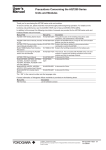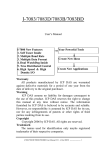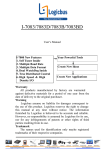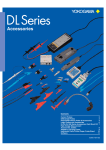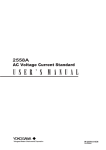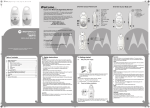Download Manual - Yokogawa
Transcript
User’s Manual Model 701926 High Voltage Differential Probe for the DL Series The following symbols are used in this manual. Improper handling or use can lead to injury to the user or damage to the instrument. This symbol appears on the instrument to indicate that the user must refer to the user’s manual for special instructions. The same symbol appears in the corresponding place in the user’s manual to identify those instructions. In the manual, the symbol is used in conjunction with the word “WARNING” or “CAUTION.” WARNING Calls attention to actions or conditions that could cause serious or fatal injury to the user, and precautions that can be taken to prevent such occurrences. Thank you for purchasing the High Voltage Differential Probe (701926) for the DL Series. To ensure correct use, please read this manual thoroughly before beginning operation. After reading this manual, keep it in a safe place. CAUTION Calls attention to actions or conditions that could cause light injury to the user or Contact information of Yokogawa offices worldwide is provided on the following sheet. • PIM113-01Z2 List of worldwide contacts Note damage to the instrument or the user’s data, and precautions that can be taken to prevent such occurrences. Calls attention to information that is important for proper operation of the instrument. 1.Description 5th Edition: November 2015 (YMI) All Rights Reserved, Copyright © 2008, Yokogawa Electric Corporation All Rights Reserved, Copyright © 2010, Yokogawa Meters & Instruments Corporation Printed in Japan This probe provides differential inputs to be used with oscilloscopes with single-ended inputs. 2.Configuration The differential probe consists of the following parts and accessories. IM 701926-01E 5th Edition Approx. 90 cm Approx. 50 cm Safety Precautions 4 Make sure to observe the following safety precautions when handling the probe. YOKOGAWA assumes no liability for the customer’s failure to comply with these safety precautions. Before you use the probe, read the measuring instrument’s manual to fully aware of its specifications and handling. 2 Parts No Black: B8099RC Red: B8099RD 3. Ground extension lead (length: approx. 100 cm) 4. Power cable* (length: approx. 150 cm) B9852MJ * Power can be supplied from a YOKOGAWA measuring instrument, 700938, or 701934.. 3.Probe Part Names WARNING Ground the measuring instrument Make sure to connect the protective grounding terminal of the measuring instrument to ground. Stop use if you suspect damage If you suspect that the probe is broken, consult your nearest YOKOGAWA dealer. Observe the maximum input voltage Do not apply voltage exceeding 7000 Vpeak between an input lead and ground or between two input leads. The maximum input voltage is 7000 Vpeak regardless of whether 1000:1 or 100:1 attenuation is used. Ground the probe Ground the probe by connecting the grounding conductor of the measuring instrument’s power cable or another appropriate grounding conductor to the BNC shell and an auxiliary grounding terminal. Before connecting the probe input terminal to the circuit under measurement, ensure that the measuring instrument is grounded properly, that the probe output connector is attached to the BNC connector of the measuring instrument, and that the auxiliary grounding terminal is connected to a proper ground. Do not remove the alligator clip’s cover To prevent electric shock or fire, do not remove the alligator clip’s insulation cover. Do not use in damp places To prevent electric shock, do not use the probe in damp places. Do not use in an explosive atmosphere To prevent fire and injury, do not use the probe in a flammable or explosive atmosphere or near steam. Do not touch exposed circuitry To prevent injury, remove metallic objects and jewelry such as rings and watches. Do not touch exposed live connections or components. Do not disassemble or modify Do not disassemble or modify the product. YOKOGAWA assumes no liability if you disassemble or modify the product. CAUTION Use the correct power supply Power the probe by using four AA dry cells, by using a 6 VDC/200 mA or 9 VDC/150 mA external power supply, or by connecting a probe power cable to the DL Series probe power supply terminal, the 700938, or the 701934. Operating the probe while using a power supply exceeding the specified voltage may cause damage to the instrument. Turn OFF the probe when connecting an external power supply Turn the probe power switch OFF when connecting or disconnecting from the external power supply. Do not install AA batteries when using an external power supply. Conditions of use This product has not been designed or manufactured for applications in which high reliability is required over a long time period. Operating environment limitations This product is a Class A (for industrial environments) product. Operation of this product in a residential area may cause radio interference in which case the user will be required to correct the interference. Waste Electrical and Electronic Equipment Waste Electrical and Electronic Equipment (WEEE), Directive (This directive is valid only in the EU.) This product complies with the WEEE directive marking requirement. This marking indicates that you must not discard this electrical/electronic product in domestic household waste. Product Category With reference to the equipment types in the WEEE directive, this product is classified as a “Monitoring and control instruments” product. When disposing products in the EU, contact your local Yokogawa Europe B.V. office. Do not dispose in domestic household waste. Authorized Representative in the EEA Yokogawa Europe B.V. is the authorized representative of Yokogawa Meters & Instruments Corporation for this product in the EEA. To contact Yokogawa Europe B.V., see the separate list of worldwide contacts, PIM 113-01Z2. 3 Standard parts 1. Probe 2. High voltage alligator clip (Two in a set) The following symbols are used on this instrument. Warning: handle with care. Refer to the user’s manual or service manual. This symbol appears on dangerous locations on the instrument which require special instructions for proper handling or use. The same symbol appears in the corresponding place in the manual to identify those instructions. Risk of electric shock Make sure to observe the following safety precautions to prevent electric shock, personal injury, or damage to the instrument. 1 ADJUST (DC offset adjustment) Attenuation ratio selector Power LED Power switch BNC output connector 4. Installing or Replacing Batteries Slide the lid on the back side of the probe, and install or replace the four AA dry cells. The probe is shipped from the factory without the batteries installed. 5.Procedure 1. Connect the provided high voltage alligator clips to the probe input leads. 2. Supply power to the probe by one of the following methods. • Install four AA cells. The power LED blinks if the battery level goes low. If this message appears, replace the dry cells. • Connect the appropriate power cable to an external power supply. • Connect the probe power cable to a probe power supply terminal on the DL Series, the 700938, or the 701934. 3. Connect the BNC output connector to the oscilloscope input terminal, and properly ground the auxiliary ground terminal. If necessary, use the auxiliary ground extension lead. 4. Turn the power switch ON, and warm up the probe for at least 30 minutes. 5. Select the appropriate attenuation using the attenuation ratio selector. •For higher resolution and less noise when measuring signals less than or equal to 700 V, switch the attenuation to 1/100. • When measuring signals greater than 700 V, set the attenuation to 1/1000. 6. If the offset voltage is large, short the alligator clips, and turn the ADJUST variable resistor (DC voltage adjustment) using an appropriate flat-head screwdriver to adjust the offset voltage. 7. Connect the two probe input leads to the two points of measurement (differential measurement). The performance declines if you only connect a probe input lead to a single point. Make sure to connect both leads. WARNING • To prevent electric shock and other accidents, make sure to connect the probe output to the properly grounded oscilloscope so that the ground end (shielded end of the BNC connector) of the output cable is grounded. • Turn OFF the power to the circuit under measurement when connecting or disconnecting the probe from the circuit under measurement. Connecting or removing the probe while the power is ON is dangerous. Do not touch the probe after turning ON the power to the circuit under measurement. Do not remove the probe from the measuring instrument while the probe is connected to the circuit under measurement. • When disconnecting the probe BNC output connector, first turn OFF the power to the circuit under measurement. Then, disconnect the probe from the high voltage parts of the circuit under measurement. • When replacing batteries or connecting an external power supply, first turn OFF the power to the circuit under measurement. Then, remove the input lead from the circuit under measurement. CAUTION • This probe is designed to measure the voltage difference between two points on the circuit under measurement. It does not electrically isolate the circuit under measurement from the measuring instrument. • Use a soft cloth to clean the probe. Be careful not to break the probe. Do not immerse the probe in liquid or use abrasive cleaners on the probe. Do not use benzene or other solvents on the probe. • Turn the probe power switch OFF when connecting or disconnecting from the external power supply. Do not install AA batteries when using an external power supply. Note • Accurate measurements may not be possible near objects with strong electromagnetic fields such as transformers, large current circuits, and wireless equipment. • Before use, flip the attenuation switch back and forth several times. The switch’s electrical contacts can weaken if not used for long periods of time. • To take accurate measurements, we recommend that you calibrate the probe once a year. IM 701926-01E 1/2 6.Specifications Item Frequency bandwidth1, 2 Input type Attenuation Output offset voltage 2, 3 Input resistance and capacitance (typical) 4 Allowable differential voltage (between + and – terminals) Allowable common mode voltage Maximum input voltage (to ground) 5 CMRR (typical) 1, 4 Output voltage 1, 2 Output impedance Gain accuracy 1, 2, 3 Operating conditions Storage conditions Operating altitude Storage altitude Power requirements 6 Battery life Warm-up time Recommended calibration period External dimensions Weight Safety Complying standards standards Emission Complying standards Immunity Complying standards Specifications DC to 50 MHz (–3 dB) Balanced differential input 1000:1 or 100:1, switchable ±5 mV or less (after adjusting the ADJUST resistor) 50 MΩ + approx. 17 pF (parallel with respect to ground) 5000 V rms or less and 7000 Vpeak or less at 1000:1 attenuation 500 V rms or less and 700 Vpeak or less at 100:1 attenuation 5000 Vrms or less and 7000 Vpeak or less 1000 Vrms CAT III 5000 Vrms or 7000 Vpeak CAT I –80 dB or less at 60 Hz, –60 dB or less at 20 kHz ±7 V (DC+ACpeak) Value when the probe is used in combination with a measuring instrument whose input resistance is 50 kΩ or higher Used on a 1 MΩ input oscilloscope ±2% 5 to 40°C, 25 to 85%RH (no condensation) –30 to 70°C, 25 to 85%RH (no condensation) 2000 m or less 3000 m or less •Internal battery: Four AA dry cells •External power supply: 6 VDC/200 mA or higher or 9 VDC/150 mA or higher, with a positive center pin. •Power is supplied through the dedicated cable B9852MJ from a YOKOGAWA measuring instrument’s probe power supply terminal or from a 700938 or 701934 probe power supply. Approx. 7 hours under continuous use (when using alkaline dry cells) At least 30 minutes 1 year 202 mm × 83 mm × 38 mm (excluding connector and cable) Approx. 500 g (excluding batteries) Probe (excluding the alligator clip) EN61010-031 Measurement category III 7 1000 Vrms Measurement category I 8 5000 Vrms, 7000 Vpeak Pollution degree 2 9 Alligator clip (B8099RC/8099RD) EN61010-031 Measurement category I 8 5000 Vrms, 7000 Vpeak Pollution degree 2 9 Probe and alligator clip 10 EN61010-031 Measurement category I 8 5000 Vrms, 7000 Vpeak Pollution degree 2 9 EN61326-1 Class A EN55011 Class A, Group 1 EMC standards of Australia and New Zealand EN55011 Class A, Group 1 This product is a Class A (for industrial environment) product. Operation of this product in a residential area may cause radio interference in which case the user is required to correct the interference. EN61326-1 Table 1 Max input voltage 1 When the supply voltage from the dry cells is 5 V or higher or when using an external power supply. 2 At an ambient temperature 23±5°C, humidity 55% ± 10% RH, 30 minutes after the power is turned on. 3 The accuracy is the total of the gain accuracy and offset voltage. 4 Typical values are typical or mean values. They are not strictly guaranteed. 5 Frequency derating (load reduction) applies. Input voltage derating 10000 1000 5000 2500 200 100 10 20 1M Frequency(Hz) 10M 100M 6 The power LED blinks if the battery level goes low. If this message appears, replace the dry cells. When using an external power supply, do not install dry cells. 7 This equipment is for measurement category III (CAT III). Do not use it with measurement category IV (CAT IV). CAT III applies to measurement of the distribution level, that is, building wiring, fixed installations. CAT IV applies to measurement of the primary supply level, that is, overhead lines, cable systems, and so on. 8 Measurement category (CAT I) applies to measurement of circuits that are not directly connected to a main power source. Forexample, this category applies to measurement of secondary electric circuits in equipment across a transformer. The estimatedtransient overvoltage for the 701926 is 0 V. 9 Pollution degree applies to the degree of adhesion of a solid, liquid, or gas which deteriorates withstand voltage or surface resistivity. Pollution degree 2 applies to normal indoor atmospheres (with only non-conductive pollution). 10When using devices with different measurement categories, the lower measurement category applies. For this probe, because the measurement category of the alligator clip is lower, when the probe and the alligator clip are used together, measurement category I (CAT I) applies. To use the probe under measurement category III conditions, use it with the 701954 alligator clip (1000 Vrms, CAT III, sold separately). IM 701926-01E 2/2



